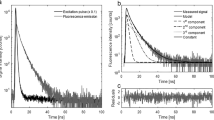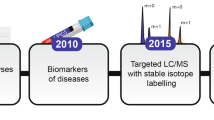Abstract
Oxidant stress has been implicated in a wide variety of disease processes. One method to quantify oxidative injury is to measure lipid peroxidation. Quantification of a group of prostaglandin F2α-like compounds derived from the nonezymatic oxidation of arachidonic acid, termed the F2-isoprostanes (F2-IsoPs), provides an accurate assessment of oxidative stress both in vitro and in vivo. In fact, in a recent independent study sponsored by the National Institutes of Health (NIH), F2-IsoPs were shown to be the most reliable index of in vivo oxidant stress when compared against other well known biomarkers. This protocol details our laboratory's method to quantify F2-IsoPs in biological fluids and tissues using gas chromatography-mass spectrometry (GC-MS). This procedure can be completed for 12–15 samples in 6–8 h.
This is a preview of subscription content, access via your institution
Access options
Subscribe to this journal
Receive 12 print issues and online access
$259.00 per year
only $21.58 per issue
Buy this article
- Purchase on Springer Link
- Instant access to full article PDF
Prices may be subject to local taxes which are calculated during checkout




Similar content being viewed by others
References
Chisholm, G.M. & Steinberg, D. The oxidative modification hypothesis of atherogenesis: an overview. Free Radical Biol. Med. 18, 1815–1826 (2000).
Halliwell, B. & Gutteridge, J.M. Role of free radicals and catalytic metal ions in human disease: an overview. Methods Enzymol. 186, 1–85 (1990).
Kadiiska, M.B. et al. Biomarkers of oxidative stress study II: are oxidation products of lipids, proteins, and DNA markers of CCl4 poisoning? Free Radic. Biol. Med. 38, 698–710 (2005).
Morrow, J.D. et al. A series of prostaglandin F2-like compounds are produced in vivo in humans by a non-cyclooxygenase, free radical-catalyzed mechanism. Proc. Natl. Acad. Sci. USA. 87, 9383–9387 (1990).
Morrow, J.D. et al. Quantification of the major urinary metabolite of 15-F2t-isoprostane (8-iso-PGF2α) by a stable isotope dilution mass spectrometric assay. Anal. Biochem. 269, 326–331 (1999).
Morales, C.R., Terry, E.S., Zackert, W.E., Montine, T.J. & Morrow, J.D. Improved assay for the quantification of the major urinary metabolite of the isoprostane 15-F2t-isoprostane (8-iso-PGF2α) by a stable isotope dilution mass spectrometric assay. Clin. Chim. Acta 314, 93–99 (2001).
Morrow, J.D. & Roberts, L.J. 2nd . Mass spectrometric quantification of F2-isoprostanes in biological fluids and tissues as a measure of oxidant stress. Meth. Enzymol. 300, 3–12 (1999).
Liang, Y. et al. Quantification of 8-iso-prostaglandin-F2α and 2,3-dinor-8-iso-prostaglandin-F2α in human urine using liquid chromatography-tandem mass spectrometry. Free Radic. Biol. Med. 34, 409–418 (2003).
Pratico, D. et al. IPF2alpha-I: an index of lipid peroxidation in humans. Proc. Natl. Acad. Sci. USA 95, 3449–3454 (1998).
Rokach, J. et al. Nomenclature of isoprostanes: a proposal. Prostaglandins 54, 853–873 (1997).
Rokach, J. et al. The isoprostanes: a perspective. Prostaglandins 54, 823–851 (1997).
Taylor, A.W., Bruno, R.S., Frei, B. & Traber, M.G. Benefits of prolonged gradient separation for high-performance liquid chromatography-tandem mass spectrometry quantitation of plasma total 15-series F-isoprostanes. Anal. Biochem. 350, 41–51 (2006).
Basu, S. Radioimmunoassay of 8-iso-prostaglandin F2α: an index for oxidative injury via free radical catalysed lipid peroxidation. Prostaglandins Leukot. Essent. Fatty Acids 58, 319–325 (1998).
Acknowledgements
Supported by NIH grants DK48831, CA77839, GM154312 and ES13125.
Author information
Authors and Affiliations
Corresponding author
Ethics declarations
Competing interests
The authors declare no competing financial interests.
Rights and permissions
About this article
Cite this article
Milne, G., Sanchez, S., Musiek, E. et al. Quantification of F2-isoprostanes as a biomarker of oxidative stress. Nat Protoc 2, 221–226 (2007). https://doi.org/10.1038/nprot.2006.375
Published:
Issue Date:
DOI: https://doi.org/10.1038/nprot.2006.375
This article is cited by
-
Association between healthy dietary patterns and markers of oxidative stress in the Sister Study
European Journal of Nutrition (2023)
-
The effects of exercise and diet on oxidative stress and telomere length in breast cancer survivors
Breast Cancer Research and Treatment (2023)
-
Pathophysiology of reversible cerebral vasoconstriction syndrome
Journal of Biomedical Science (2022)
-
Association of dietary and plasma carotenoids with urinary F2-isoprostanes
European Journal of Nutrition (2022)
-
Association of continuous positive airway pressure with F2-isoprostanes in adults with obstructive sleep apnea: a meta-analysis
Sleep and Breathing (2019)
Comments
By submitting a comment you agree to abide by our Terms and Community Guidelines. If you find something abusive or that does not comply with our terms or guidelines please flag it as inappropriate.



